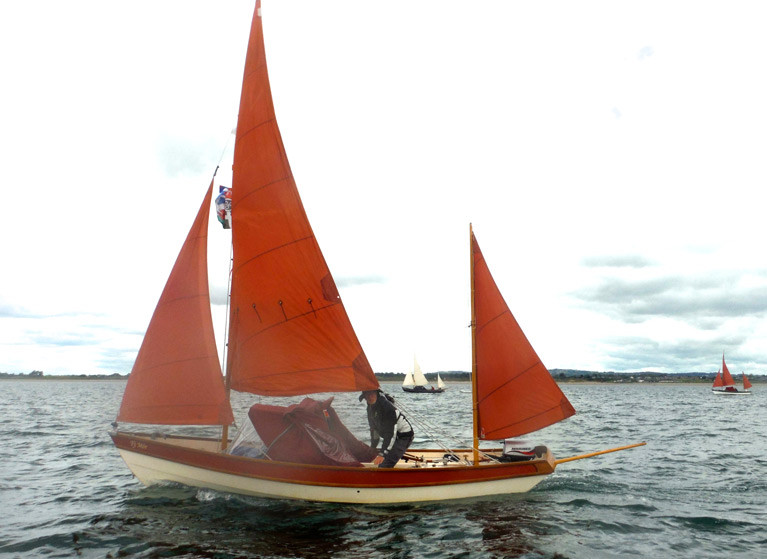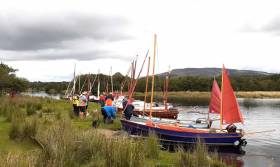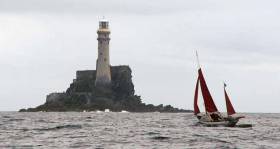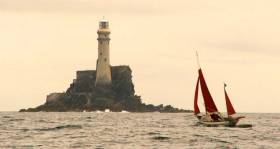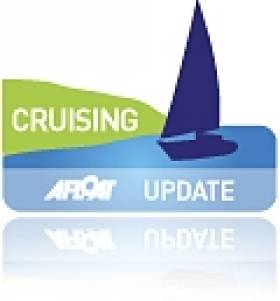Displaying items by tag: Drascombe
Jack O'Keeffe of Cork Harbour Becomes Chairman of International Drascombe Association
The many, varied and characterful boats of the Drascombe range became even better known throughout Ireland during 2020. Their trailerable flexibility of logistics and boat-positioning - together with their Association's long experience in organising cruises-in-company and rallies to remote coastlines and lakes - enabled them to give textbook lessons in how to comply with pandemic regulations while still providing their flotillas and small fleets with worthwhile ventures afloat and ashore. Our report of their Boyne Rally in July was very typical of the special ingenuity which the Drascombes deploy in getting to the places other boats don't reach.
The Drascombe Association's main man in coordinating a varied programme of rallies in Ireland and the UK through 2020 was Jack O'Keeffe of Cork – of Carrigaline, to be precise. And whatever he did during the past year or so, it seems to have been neatly on target, as the Association's recent online AGM saw him being elected Chairman for the next two years, heading up an organisation which has members and officers based in several countries, with the most distant being in Australia.
 Jack O'Keeffe of Cork Harbour, newly-elected Chairman of the internationally operating Drascombe Association, has been involved with Drascombes since 2002.
Jack O'Keeffe of Cork Harbour, newly-elected Chairman of the internationally operating Drascombe Association, has been involved with Drascombes since 2002.
They produce an attractive professional-standard quarterly news-letter which everyone knows as DAN (Drascombe Association News), and here too the O'Keeffe household is involved, as Jack and his wife Anne are the proofreaders, but Jack tells me that it's really Anne alone – "she can pick up a typo at a hundred yards….".
Meanwhile, he'll be busy enough with other work, as he has been retained as Rally Coordinator. The difficult organisational environment of 2020 saw the Drascombe Association availing of Jack's skill, as their main rally in Ireland in August on Lough Corrib – with the Rev David Williams of Cong as the on-site organiser – had a problem of success, with 27 boats applying to take part when the regulations then in force limited the fleet to 15.
So they made it two fleets, with Jack O'Keeffe leading one group starting on the Friday, while the Reverend led the others next day. It says much for the size and variety of island-studded Lough Corrib, that the two groups managed to avoid each other, yet had themselves a fine old time at some of Lough Corrib's more intriguing ports and islands.
This year the main rallies in Ireland will be a first one off the northern coast to Rathlin Island and then back to Strangford Lough in June, culminating on June 18th with a rally at the Down Cruising Club Lightship HQ, the focus for Strangford Lough's growing fleet of Drascombes. After that between July 18th and August 9th, the fleet will be working their way along the coast of Northern Ireland to the River Bann, and thence upriver to Lough Neagh.
 Reaching the places other boats don't reach - Drascombes together at Staleen on the River Boyne, 12th July 2020.
Reaching the places other boats don't reach - Drascombes together at Staleen on the River Boyne, 12th July 2020.
Far to the southwest, there's a rally at the Kenmare River on August 21st & 22nd, and then in September there's what well could become the big one, the Autumn Rally on Lough Derg around the weekend of September 10th to 12th.
It's a challenging programme when you remember that Drascombe owners tend to be highly individualistic types who - from time to time – also like to do their own thing. But an overview of 2020's successfully completed activities suggests that beneath its amiable and easygoing image, the Drascombe Association is an extremely effective organisation. Yet when I asked the new Chairman what was the secret of it all, he immediately replied with a chuckle: "A bit of luck goes a long way".
The uniquely compact boats of Ireland’s characterful Drascombe fleet have their own way of doing things. Encouraged by their easily-lowered rigs and extra-shoal-draft-with-centreboard versatility, they’re well able to explore little-known harbours and winding waterways where bridges or overhanging trees might make cruising impossible for more orthodox craft.
Yet they’re also deservedly renowned as able sea boats. Here in Ireland, at least one has made the circuit cruise, with the young Ogden brothers from Baltimore getting round in their Drascombe Lugger in 2015, while others have been to the Outer Hebrides. And of course the American Webb Chiles saw no reason why he shouldn’t sail across the Pacific in a Drascombe, and did so, and subsequently, he has sailed round much of the world using several of these distinctive little craft.
So it’s entirely in keeping with their able boats and individualistic approach that the Irish Drascombe Association should see the history-laden links of the 12th July 2020 - the 330th Anniversary of the Battle of the Boyne - as providing the ideal occasion to hold a Boyne Rally using the cruising potential of the partially restored Boyne Navigation, with the fleet made up from the north and the south of Ireland for a cruise-in-company involving sea passages and river transits.
 Peaceful invasion. Drascombes from north and south anchored at Staleen on the Boyne Navigation on the morning of Sunday, July 12th, 330th Anniversary of the battle of the Boyne. Photo: Jack O’Keeffe
Peaceful invasion. Drascombes from north and south anchored at Staleen on the Boyne Navigation on the morning of Sunday, July 12th, 330th Anniversary of the battle of the Boyne. Photo: Jack O’Keeffe
As is expected with the 12th July and the days around it, many flags were flown by a fleet of eleven Drascombes (five from the north and six from the south) along the Boyne water. But it was all in a spirit of the warmest friendship and a shared enthusiasm for special boats and the unique exploration opportunities they provide, with a potentially complex six-day programme involving distant launching points and coastal passage-making, with a growing fleet and stopover ports towards the Boyne.
 The man to find any coast’s hidden places – small boat cruising enthusiast Jack O’Keeffe. Photo: W M Nixon
The man to find any coast’s hidden places – small boat cruising enthusiast Jack O’Keeffe. Photo: W M Nixon
It was smoothed out by John White from the north shore of Carlingford Lough for the northern division, who launched on the afternoon of Wednesday, July 8th at Greencastle at the entrance to Carlingford Lough, and Jack O’Keeffe of Cork, whose group from the south had their most southerly launch point at Skerries. Others from north and south launched at Port Oriel at Clogherhead where the total fleet was finally assembled on the evening of Friday, July 10th, with those who’d sailed there reporting a variety of seagoing experiences.
The northern group had stopped at Gyles Quay under the Cooley Mountains and enthused about the extraordinary selection of bird-song to be heard in wildfowl-rich Dundalk Bay, while those from the south had seen the most exploration by Jack O’Keeffe, whose passage northward had included a brief diversion up the shallow River Nanny at Laytown, “the only harbour in all County Meath”, which is just the kind of thing you do with a Drascombe.
 The Drascombe Boyne Cruise as approached from the south at Skerries. Jack O’Keeffe from Cork took his own sea road less travelled – he diverted briefly into the River Nanny on the coast east of Julianstown, where Laytown is “the only harbour in all County Meath”
The Drascombe Boyne Cruise as approached from the south at Skerries. Jack O’Keeffe from Cork took his own sea road less travelled – he diverted briefly into the River Nanny on the coast east of Julianstown, where Laytown is “the only harbour in all County Meath”
Port Oriel provided the opportunity to liaise with Sean Flanagan of the RNLI whose local knowledge was invaluable, and then Saturday morning saw the combined fleet sail south round Clogher Head, and into a first river stop in the Boyne estuary at Mornington to see how helpful advice from Drogheda Harbour Master Martin Donnelly helped shape their plans for the day.,
With low water there at 1045, the tide was soon flooding up the history-laden waterway into the heart of Ireland past Drogheda, where the best berth for Drascombes was at anchor off the Coast Guard slip. There, they were made welcome by the Coast Guards, and some took the opportunity to explore the nearest parts of an ancient port city which at one time rivalled and even exceeded the seaborn trade going through Dublin.
Knowing they’d need to lower masts to negotiate bridges on the next stage upstream, some simply did it at anchor in a neat demonstration of Drascombe convenience, while others did it at a handy berth alongside a dredger, and then there were good wishes from the shore and from above from spectators as they negotiated the bridges to reach the sea lock into the Boyne Navigation 2.5 miles upriver of the Coast Guard slip.
 Queuing to get through the sea lock at Idebridge. Photo: Myrrthin James
Queuing to get through the sea lock at Idebridge. Photo: Myrrthin James
The members of the Boyne Branch of the Inland Waterways Association of Ireland have been restoring their bit of navigable water for some time now, but as it’s an outlier which does not connect with the main waterways system, it has often been a lonely struggle. The Covid Lockdown had not helped in having the locks in full working order, but as the Drascombe Weekend approached, they put in a heroic effort led by Stephen Early, who was helped on the day by the Boyne IWAI’s Anne Gregory, Willie O’Donnell and Fiachra de Reoise to make sure everything was functioning and undergrowth cleared along this well-wooded waterway.
 Willing helpers – IWAI Boyne branch members (left to right) Anne Gregory, Stephen Early, Willie O’Donnell and Fiachra de Reoise put in much effort to ensure the way was clear for the Drascombe fleet. Photo: Jack O’Keeffe
Willing helpers – IWAI Boyne branch members (left to right) Anne Gregory, Stephen Early, Willie O’Donnell and Fiachra de Reoise put in much effort to ensure the way was clear for the Drascombe fleet. Photo: Jack O’Keeffe
 Trevor Williams brings his Drascombe through the magic green tunnel. Tree growth is so lush and rapid along the Boyne that maintaining air draft can be an even bigger challenge than retaining channel depth. Photo: Myrrthin James
Trevor Williams brings his Drascombe through the magic green tunnel. Tree growth is so lush and rapid along the Boyne that maintaining air draft can be an even bigger challenge than retaining channel depth. Photo: Myrrthin James
As a result, a milestone was smoothly passed with the Drascombes providing the largest number of boats to transit the restored lock at once, in fact numbers were such that it had to be done in two batches of six each. Once through and above the salt water, they were into such a different world, with trees and meadowland and rural aromas, that it was difficult to remember that only that morning they’d been in been in sea-dominated, fishing-boat-flavoured Port Oriel.
 Not even a hint of salt water – quiet spot for the night at Staleen. Photo Jack O’Keeffe
Not even a hint of salt water – quiet spot for the night at Staleen. Photo Jack O’Keeffe
And the transformation was made even more complete by their overnight fleet stop at Staleen which was total country – kingfishers and other waterfowl, quietly evocative rural sounds, atmospheric sunset, and everyone dining on board their little boats in a shared mood of bliss.
 The dawn chorus greets the misty sunrise and Drascombes asleep in the Boyne Navigation on the morning of Sunday July 12th 2020, the 330th Anniversary of the Battle of the Boyne. Photo: Jack O’Keeffe
The dawn chorus greets the misty sunrise and Drascombes asleep in the Boyne Navigation on the morning of Sunday July 12th 2020, the 330th Anniversary of the Battle of the Boyne. Photo: Jack O’Keeffe
Morning came early on their central target date of Sunday12th July, with the dawn chorus at full strength by 0500 hrs as the sun emerged through the mist. It was a busy day with a morning stroll along the Boyne Footpath to meet Claidbh Gibney at the Boyne Currach centre with its fascinating demonstration of ancient boat-building, with the bonus of his encyclopaedic knowledge of much local coastal and river lore.
This included an enthusiastic outline of the “lost” medieval harbour of St Denis close west of Port Oriel, which resulted in a typically easily-made Drascombe change of plan, as they agreed they’d spend that last night at St Denis rather than Port Oriel, persuaded by Claidbh by his assurance that he’d be there to guide them in.
But there was much to be done before they reached that mysterious place, for by lunchtime they’d made their way along the short haul on the waterway to Oldbridge and the gardens of the Battle of the Boyne centre, where the arrival of a mini-fleet proudly displaying flags of north and south in a spirit of warm friendship on the 12th July really was something very special indeed, even if the Covid-restrictions mean that Oldbridge House itself is closed until July 20th.
 The Drascombes used the layby at the Turf Lock for a handy berth to visit Oldbridge House at the site of the Battle of the Boyne on July 12th. As it happens, with Oldbridge House itself closed because of COVID-19, this friendly little fleet provided the only show in town on the 330th Anniversary of the history-changing battle. Photo: Jack O’Keeffe
The Drascombes used the layby at the Turf Lock for a handy berth to visit Oldbridge House at the site of the Battle of the Boyne on July 12th. As it happens, with Oldbridge House itself closed because of COVID-19, this friendly little fleet provided the only show in town on the 330th Anniversary of the history-changing battle. Photo: Jack O’Keeffe
In fact, this meant that the Drascombes – who are more accustomed to doing their own thing quietly under the radar – were akin to being the main event at the site on the 330th Anniversary of the Battle of the Boyne on July 12th 2020. But they took it in their stride with the usual mixture of banter and boat talk which soon took on an extra purpose as the turn of the tide was approaching, so it was back to seafaring business as they headed down through the sea lock with their two transits, and then with a fine fair ebb, made short work of negotiating Drogheda’s bridges and the lengthy stretch along the estuary to Mornington, accompanied all the way by the folk from Boyne IWAI and the Boyne Currach centre.
 The route taken from far inland on the Boyne to the ancient “forgotten” harbour of St Denis west of Port Oriel
The route taken from far inland on the Boyne to the ancient “forgotten” harbour of St Denis west of Port Oriel
Mornington was a hive of activity afloat with boats being made ready for sea, as the introduction of the ultra-ancient harbour of St Denis into their cruise-in-company plan gave an added urgency. But by 1800 hrs they were emerging on time into the Irish Sea at Boyne Mouth, and a crisp two hour passage northward around rugged little Clogher Head took them past Port Oriel and on towards that barely-visible indentation of the coast where the remains of the medieval harbour that used to serve the sacred St Denis’s Well were to be found.
Claidhbh (Clive) Gibney was there, ready on the shore to guide them in, his readiness and enthusiasm being such that he promptly waded in chest deep to make sure they found the channel, and then provided the additional service of “walking the seabed” where each boat chose to anchor to ensure that they wouldn’t be settling on a boulder at low water.
 Late on a summer’s evening at low water in the ancient harbour of St Denis. Thanks to Claidhbh Gibney of the Boyne Currach Centre “walking the seabed” for the fleet while chest deep in the sea, all settled comfortably into a drying berth free of boulders. Photo: Pat Jones
Late on a summer’s evening at low water in the ancient harbour of St Denis. Thanks to Claidhbh Gibney of the Boyne Currach Centre “walking the seabed” for the fleet while chest deep in the sea, all settled comfortably into a drying berth free of boulders. Photo: Pat Jones
This was purest Drascombe territory. An elusive wraith of a forgotten port being brought briefly back to life for the fleet’s last overnight together, with few if any lights visible from the nearby shore as the summer night closed in. Yet again, there was enormous effort needed to realise that their day had started in a very different place, deep in the heart of the country as the dawn chorus grew in strength over the mists of the Boyne on the anniversary of the history-changing battle.
 “Teatime at St Denis Harbour” – on the last night together in this memorable miniature Cruise-in-Company, it was a time for reflection and friendship. Photo: Myrrthin James
“Teatime at St Denis Harbour” – on the last night together in this memorable miniature Cruise-in-Company, it was a time for reflection and friendship. Photo: Myrrthin James
Their final morning together provided the time for an exploration of the remains of the forgotten St-Denis harbour’s walls before the new tide floated them off and the fleet dispersed – some north to Carlingford and Greencastle, and others swiftly south towards Skerries along the now-familiar coast of County Louth, all making good progress – whether headed north or south – in a healthy west wind off the land – “off the grass” as the crewmen in Irish Lights fondly describe it – to find their road trailers and the way home.
By Tuesday night, all were safely back in their home ports, which in many cases means on the road trailer in the front drive. Yet as the Boyne 12th July Long Weekend had well shown, if it’s a Drascombe on that trailer, your home port will give ready access to some truly intriguing cruising grounds very remote indeed from modern suburbia.
Drascombes Disappear into Ireland’s Most Meandering Inland Waterway
What is the most meandering bit of waterway in all Ireland? Obviously it would be a river. And surely it would have to be a river trying to get across a very large area of flat country where, over the centuries, indeed over very many centuries, it has slowly carved out a channel which twists and turns back on itself in the best style of the mighty Amazon at its most tortuous?
Not so. For if you rule out Upper Lough Erne - where the myriad-like waterway is finding its path through natural drumlin country with many islands involved - the length of waterway which seems to come top of the bill in the maze-like meandering stakes seems not to be in a large open plain at all, but rather in a relatively small area of presumably alluvial flat land at the north end of Lough Allen in one of the least-known parts of Ireland.
There, the meandering waterway is the infant Shannon, finding its route south to the first of its many grown-up lakes, Lough Allen in the depths of Leitrim. And Lough Allen is a very grown-up lake indeed - definitely not to be trifled with.
In fact, Lough Allen has such a reputation for the dangers of its wide open water and sudden storms from the brooding hills and mountains about it that for long enough there seemed to be a reluctance by the Powers That Be to acknowledge that it was a proper part of the Irish Inland Waterways system at all.
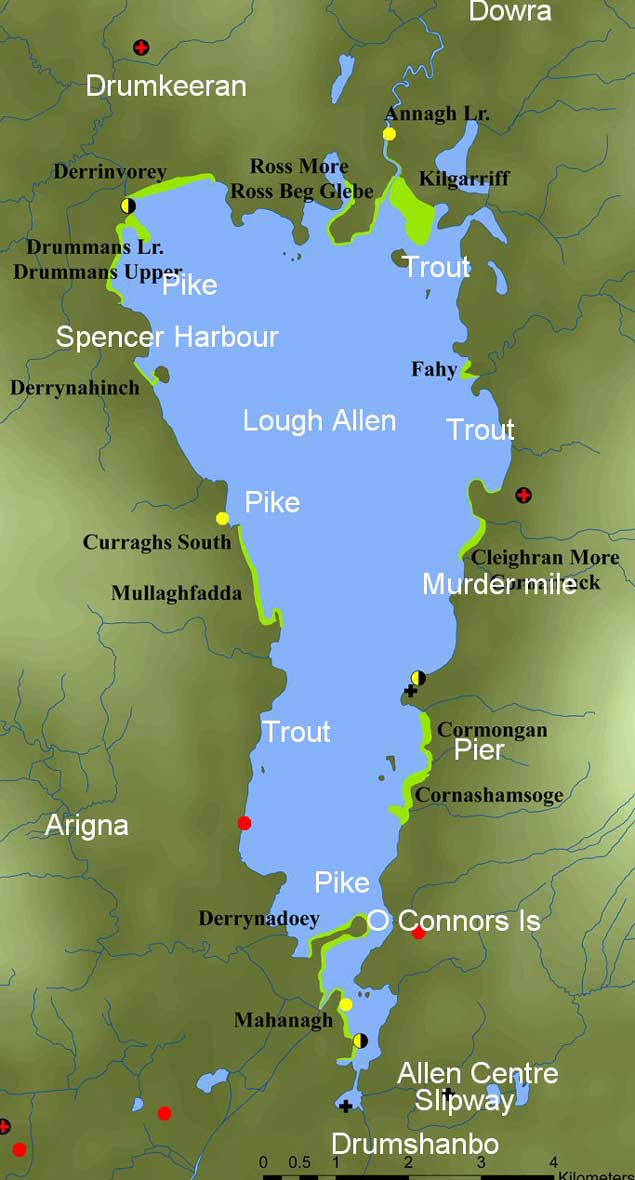 Lough Allen is big, and open with it while being set amidst hills and mountains. The lake is best known to anglers, while for a small cruising boat, Dowra in the remote northern area can seem very far away from the hub of civilization at Drumshanbo.
Lough Allen is big, and open with it while being set amidst hills and mountains. The lake is best known to anglers, while for a small cruising boat, Dowra in the remote northern area can seem very far away from the hub of civilization at Drumshanbo.
A clinching argument against making it popular was that when the main system is low in water, Lough Allen is seen as a reservoir of very handy spare power by the engineers way downstream at the Ardnacrusha Hydro-Electric Dam just above Limerick. There, the sudden use of the far northern lake to boost the system might lower Lough Allen’s level enough to cause damage within a short time to any boats which were berthed in any harbour that they – the Powers That Be - might care to provide on it.
But as the popularity of Ireland’s inland waterways grew, the folk on the shores of Lough Allen stepped up their demands to be included in the big holiday afloat picture, and though there were few enough of them pushing the case - for it’s not exactly a densely-crowded region - in the end they won through.
Lough Allen officially became part of the big scheme of things in the recreational waterways network, and a permanent harbour was installed at the site of the old barge-using Spencer Harbour in the west shore, a summer harbour was made available at Cleighran More on the east shore, and down towards the south of Lough Allen where the now substantially larger Shannon exits the lake at Drumshanbo, it became a veritable Riviera with all sorts of facilities on the shores and in the river alike.
But the one fascinating feature which was very determinedly excluded from the new dispensation of accessibility was the baby Shannon coming into the top end of the lake. For it appears into the lake out of unknown roadless territory, with reportedly impenetrable forest, until suddenly it could be sighted again something like two or three miles away northwards as the crow flies, coming through under the bridge in a place called Dowra.
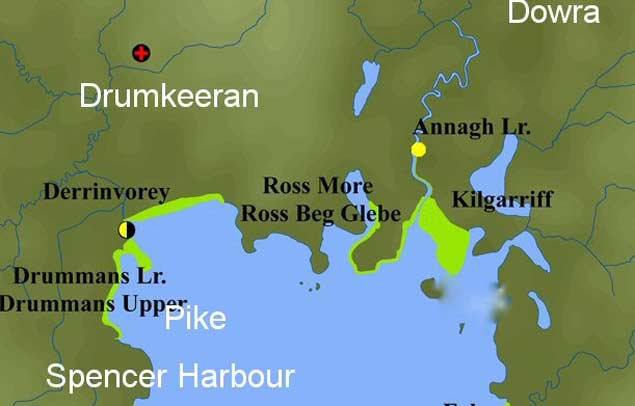 If you can negotiate the winding upper Upper Shannon from Lough Allen to Dowra, you’ll find you have travelled nearly twice the direct distance from the lake
If you can negotiate the winding upper Upper Shannon from Lough Allen to Dowra, you’ll find you have travelled nearly twice the direct distance from the lake
Now Dowra really is a place apart. It is one of those villages where the highlands meet the rest of the country, cramped in under the hills with the street bustling with mountainy men driving battered 4X4s with old trailers full of sheep in tow, and ever-alert collies beside them. It’s very workaday and not picturesque in the official sense, and about as different as possible from the smooth style which you get not so very far away on the inland waterways at Lough Key or in the high-tech affluence of Carrick-on-Shannon.
In fact, there’s a sense of the frontier about it. Not in the official border way, but rather in the feeling that just beyond Dowra as the hills close in, you’ll find ancient signs warning that Here Be Dragons….. At least, that’s the impression it made on me first time I drove into the village from the southwards, coming along the gentle lakeside road to the east of Lough Allen. It seems to be an attitude generally shared in the administration of Waterways Ireland. For when you’re out on Lough Allen and wonder what it might be like to wander up the young Shannon and see where it has come from out of all those hills and mountains, there’s a very clear sign telling you to stop thinking any such thing.
 “You can’t go there!” Bill Lart’s historic prototype Drascombe Longboat Orca heads for the hidden infant Shannon past the marker telling him otherwise…..Photo: Kim Roberts
“You can’t go there!” Bill Lart’s historic prototype Drascombe Longboat Orca heads for the hidden infant Shannon past the marker telling him otherwise…..Photo: Kim Roberts
Needless to say such signs are seen as invitations to explore by any curious boater, and I’ve no doubt sundry small craft and kayaks in particular will have found their way up the winding rive and under the trees – in some places the Irish equivalent of a mangrove swamp - to within at least shouting distance of Dowra, and probably all the way to the place itself.
Certainly the Drascombe Association – with whom we were last cruising about a year ago, when they were right up the Slaney to Enniscorthy and then out into the wide expanses of Wexford Harbour as part of their Golden Jubilee celebrations – felt that the mysterious north end of Lough Allen was exactly the kind of place their characterful selection of boats were made to explore. So last weekend they made something of an expedition to Lough Allen and nearby Lough Arrow, and the one and only Jack O’Keeffe of Cork takes up the story:
“On Saturday a fleet of ten Drascombes sailed north up Lough Allen past the "End of Navigation" notices and into the Shannon river that feeds Lough Allen. They discovered that having negotiated the final completely unmarked approach to the river, they entered a deep meandering waterway, beautifully wooded and isolated from roads or and sort of commercial or farming activity.
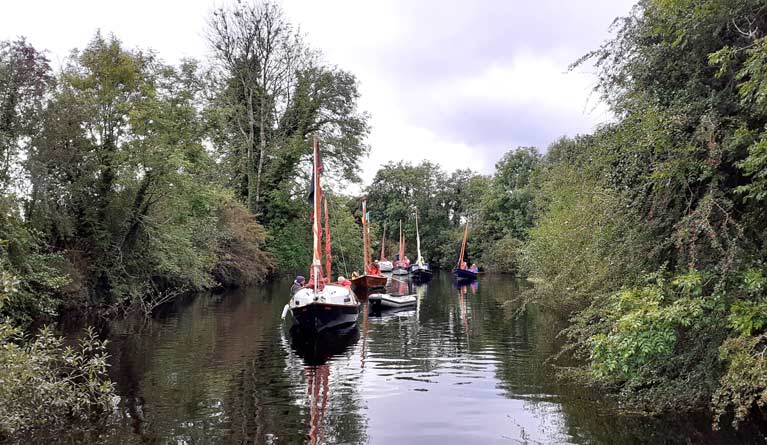 Into the jungle – the infant Shannon provides an Irish version of a mangrove swamp as the Drascombe fleet get as far as they could go with their masts still up towards Dowra last Saturday. Photo: Malcolm Kindness
Into the jungle – the infant Shannon provides an Irish version of a mangrove swamp as the Drascombe fleet get as far as they could go with their masts still up towards Dowra last Saturday. Photo: Malcolm Kindness
The fleet explored the unused river to within a mile of Dowra village, at which point the tress merged overhead, and masts would need to be lowered to pass. With ten boats in the fleet and picnic time approaching, the best option was to find the true limits of navigation on another visit.
There is plenty of water in the river - 3m to 6m - and enough width to turn a 7m Drascombe. (Ed’s note: Detailed maps suggest there is a handy “turning pool” almost at Dowra itself). The fleet stopped off at the entrance to the lake for our al fresco feast, and then returned to the Lough Allen Centre at Drumshanbo via Spencer Harbour on the west shore, an all-weather amenity in a seemingly unpopulated area.
Then on Sunday the fleet were well hosted by Bryan and Crea Dobson at Cleighran More Harbour on the east shore, and took in a visit to the nearby sweathouse, unfortunately not in use since the 1700s - a slight disappointment for anyone who wanted to try a traditional ancient old Irish-style sauna.
Certainly the fleet included people with a lively interest in the past, and our flotilla of ten included two specimen boats, Bill Lart’s Orca from the UK which was John Watkinson’s prototype Drascombe Longboat, and Kim Roberts from Kilrush on the Shannon Estuary with Sanderling, a beautifully restored and maintained wooden Drascombe Lugger, now over 40 years old.
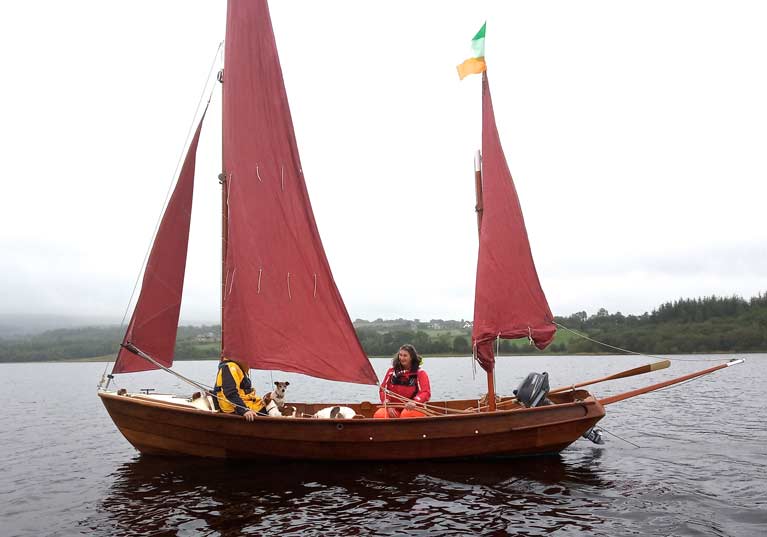 Kim Roberts’ classic wooden 40-years-plus Drascombe Lugger Sanderling with a full crew of old sea dogs of all ages on Lough Allen. By getting upriver towards Dowra, she was as far as she could get on the River Shannon from her home port of Kilrush on the Shannon Estuary. Photo: Jack O’Keeffe
Kim Roberts’ classic wooden 40-years-plus Drascombe Lugger Sanderling with a full crew of old sea dogs of all ages on Lough Allen. By getting upriver towards Dowra, she was as far as she could get on the River Shannon from her home port of Kilrush on the Shannon Estuary. Photo: Jack O’Keeffe
Some of the fleet came to Lough Allen after first taking a road-trailered diversion to sail the notably attractive Lough Arrow over the hills to the west towards Sligo, something which became a bit of a spectacle as there seemed to be no local recollection of sailboats on Lough Arrow any time before”.
In fact, the Varian sailing family of Dun Laoghaire had a fishing lodge on Lough Arrow, and it’s believed they’d sailing boats there, including perhaps a Shannon One Design.
Before this joint expedition, many of the Drascombe sailors knew little of Lough Allen, and some from the UK had never even heard of it. They say that when you visit somewhere interesting and new, you should always leave something still to be seen on a next visit.
Now that they know what might be needed to get all the way up to Dowra, it will be kept in mind by the Drascombe folk for some future date. Meanwhile, they suggest that Waterways Ireland should think about providing a landing place at Dowra, as the thick undergrowth makes it very difficult to get ashore anywhere near that remote village.
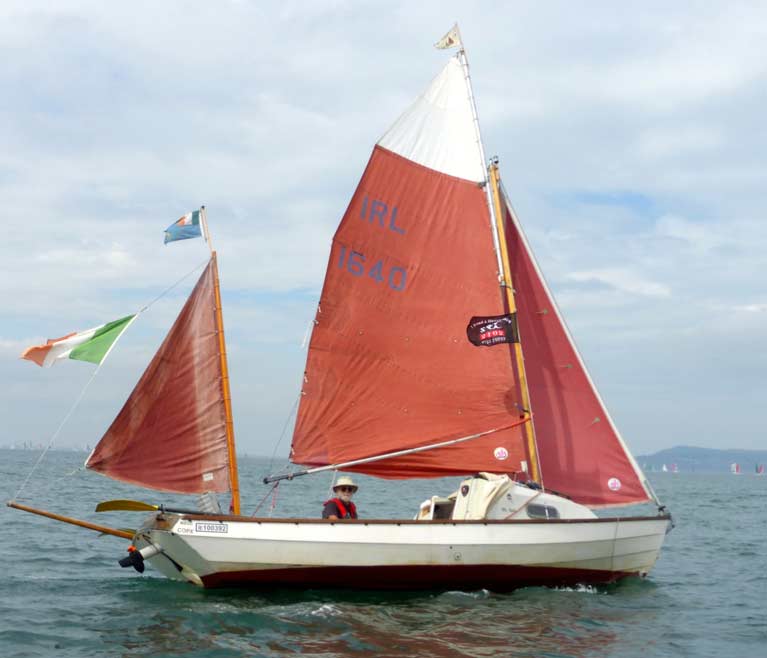
Drascombe Fleet to Cruise Wexford and Slaney this Weekend
The Drascombe Association have been celebrating their own 30th Anniversary, and the Golden Jubilee of the introduction of their distinctive range of characterful boats, with special enthusiasm in Ireland this summer writes W M Nixon.
It happens to be a rule of the Association that their annual conference and dinner is held in the home town of the Chairman. And as current chairman John Stanage lives in Belfast, that city’s famous Baroque City Hall was the setting for the Annual Dinner in May, with the launching of an ambitious programme.
But Drascombe sailors being a highly individualistic bunch who often go their own sweet way rather than sail in a crowd, the highest ambition of any “ambitious Drascombe programme” is to accommodate that individuality, while still ensuring that there is a general shared movement towards some agreed destination.
So a lot of what has been taking place is low key, though they did put their heads above the parapet with participation in the Classic & Traditional Kingstown 200 Class in the Volvo Dun Laoghaire Regatta 2017 in July.
However, later that month they were to be found rallying in Connemara and out to the Aran Islands, then across to the Clare coast. That sort of multi-faceted activity showed the Drascombes at their versatile best, but this weekend from Friday evening (August 25th) through to Sunday evening (August 27th) they’re getting together in a place which might have been designed with Drascombes in mind.
 The port of Wexford. The River Slaney winds temptingly through the attractive countryside beyond the bridge, yet that bridge is a barrier for larger craft hoping to explore inland
The port of Wexford. The River Slaney winds temptingly through the attractive countryside beyond the bridge, yet that bridge is a barrier for larger craft hoping to explore inland
For sailors with deep-draft high-masted boats, Wexford and the Slaney Estuary is a frustration, for although you can berth in the town below the bridge, for most boats with masts that bridge is an impassable barrier, something which makes the pleasant-looking countryside upriver beyond it seem even more attractive.
But all this is accessible to a Drascombe, while at the same time they can enjoy the hospitality of Wexford town like any larger cruiser in from sea. Yet unlike the larger cruisers, they can also cruise more extensively in the shoal outer harbour, which they’ll be doing on Saturday, and then on Sunday morning’s tide, they hope to get right up the Slaney to Enniscorthy
The organisation on the ground with the friendly Wexford Boat & Tennis Club is with John and Darina Tully, while the Drascombe Association’s officer for rallies, Jack O’Keeffe of Cork, is also involved.
With the bank Holiday in the UK on Monday, it’s expected that there’ll be boats across via the Rosslare ferry, and as numbers are pushing towards the 20 mark, it’s being referred to as The Grand Fleet Celebration. The festivities don’t end there, for a week later on Friday September 1st, the Drascombes gather at Dromineer on Lough Derg, always a popular venue.
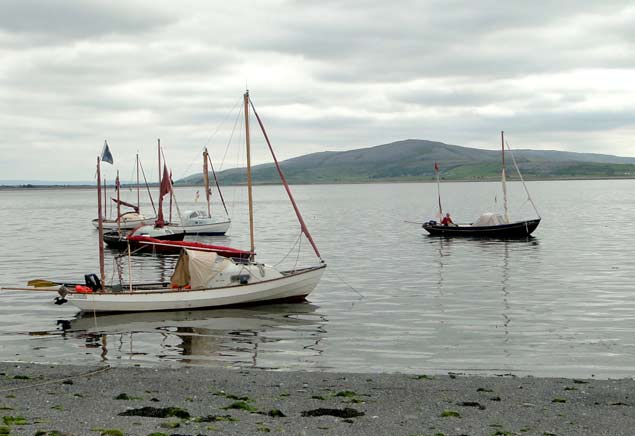 Drascombes cruising Galway Bay in July – at lunchtime, you just stop off at the handiest bit of shore. Photo: Jack O’Keeffe
Drascombes cruising Galway Bay in July – at lunchtime, you just stop off at the handiest bit of shore. Photo: Jack O’Keeffe
"It Is Considered Quite Vulgar to Race” – Drascombes Celebrate Golden Jubilee in Belfast
The members of the Drascombe Association celebrated 50 years of their boat in Belfast at the weekend. Five thousand Drascombes have been built and their owners enjoy sailing them. That was the message of the Secretary of the Irish branch of their Association, Jack O’Keeffe, when I talked to him for this week’s Podcast.
The Association has 56 rallies planned this year and, where necessary they will move their vessels at a speed of up to 50 knots, or mph - if you take note that they mean towing them by road to those rally locations. Being able to trail the boats is an advantage to owning them!
But racing is not for them!
“It’s considered quite vulgar to race,” Jack told me, though conceding that when at least two Drascombes meet they will test their speed against each other. However, racing would be “like putting little old ladies into dancing dresses.”
This is an interview you will enjoy, I think, no matter what kind of boat you sail or are interested in. And if you should be interested in acquiring a Drascombe, Jack O’Keeffe outlines how to find one – and that in itself is unusual.
I started by asking him about last weekend’s celebratory gathering in Belfast City Hall.
• For more information about Drascombes in Ireland go to the Association’s website: www.drascombe.ie
Dun Laoghaire Bicentenary Sailing Regatta Takes on Interesting New Acts
With some visionary thinking by Cathy MacAleavey in her capacity as chief of the sub-committee organising the Classics, Traditional and Old Gaffers section of the Volvo Dun Laoghaire Regatta & Harbour Bicentenary Festival from June 6th to 9th, the scope of the event is going to become even more varied and certainly more colourful. As W M Nixon has discovered, she has been spreading the net wide:
“We’ve never been asked to take part in a regatta before. Never. So of course we’ll be there. And I personally am looking forward to it very much indeed.”
The speaker is Jack O’Keeffe of Cork, one of the main men in the Irish Drascombe Association, and also the overall association’s organizer of Rallies. While his members with their distinctive and extensive selection of tanned-sailed little boats are a familiar sight in Ireland and elsewhere as they stage their various rallies and other events, despite the well-known distinctive blue-green hull colour with which they were introduced being known throughout the country, nobody seems to have thought of them before as worthy participants as a class of their own. Not even as part of a menagerie class in a local regatta, let alone as playing a significant role in major events. But Cathy did her usual bit of lateral thinking, and the result is a whole new fleet for the Dun Laoghaire festivities.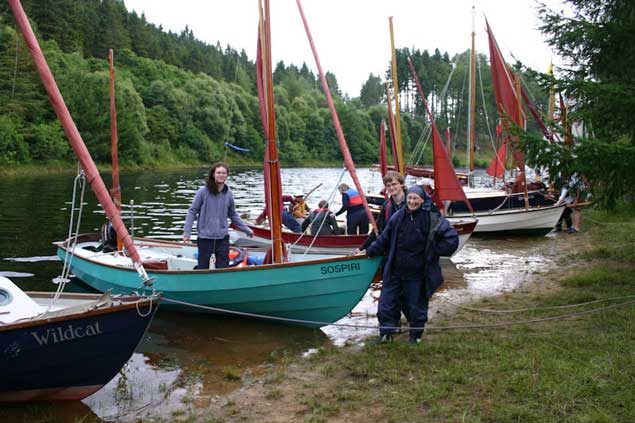 Traditional perceptions remember the Drascombes as all having that distinctive blue-green colour, but they’ve been multi-hued for years.
Traditional perceptions remember the Drascombes as all having that distinctive blue-green colour, but they’ve been multi-hued for years.
In Dun Laoghaire, the very fact that the Drascombes within their different types are broadly One-Design should see them encouraged, for in the home of One Design racing, it is only relative speed which is significant. Broadly speaking, every Drascombe will be sailing at much the same fairly leisurely speed, and they’ll all be manoeuvring in sync with that admirable Drascombe dignity. If that’s not a formula for good one-design racing, then I don’t know what is.
Yet while they may not break world sailing speed records, Drascombes certainly do sail – think of the Ogden brothers who sailed round Ireland in their Drascombe Lugger in some decidedly rugged conditions in 2015. Others, believe it or not, have crossed oceans. And on top of that, if they have managed to wend their way into the head of some peaceful creek at the end of day’s sailing, the lack of shore facilities is no problem, as most Drascombes provide rudimentary accommodation, quite commodious in some cases.
 "We’ve done it!” The Ogden brothers sail their Drascombe back into Baltimore at the completion of their round Ireland cruise.By a happy coincidence, 2017 is a special year, as it more or less marks the Golden Jubilee of the time Devon boat-builder John Watkinson started designing characterful seaworthy little boats which reflected the rigs of earlier times. It was in 1968 that he took the final 1967-built prototype to the London Boat Show and sold her within 20 minutes of opening, coming home with orders for 19 sister-ships to a concept whose popularity is proven by the fact of there now being 5,000 currently afloat.
"We’ve done it!” The Ogden brothers sail their Drascombe back into Baltimore at the completion of their round Ireland cruise.By a happy coincidence, 2017 is a special year, as it more or less marks the Golden Jubilee of the time Devon boat-builder John Watkinson started designing characterful seaworthy little boats which reflected the rigs of earlier times. It was in 1968 that he took the final 1967-built prototype to the London Boat Show and sold her within 20 minutes of opening, coming home with orders for 19 sister-ships to a concept whose popularity is proven by the fact of there now being 5,000 currently afloat.
The Golden Jubilee celebrations have already got under way with a party at the recent London Boat Show, but thanks to the Drascombe Association’s tradition of having the annual conference and dinner in the home town of the current overall chairman, the big party is going to be in Belfast City Hall on the weekend of March 25th to 26th, as the Drascombe Association’s Chairman of for 2017 is John Stanage of Belfast.
 A remarkable setting for the Drascombe Association’s Golden Jubilee celebration at the end of March 2017 – Belfast City Hall, completed in 1906, was an exuberant expression of a rapidly-growing city at the height of its industrial power.
A remarkable setting for the Drascombe Association’s Golden Jubilee celebration at the end of March 2017 – Belfast City Hall, completed in 1906, was an exuberant expression of a rapidly-growing city at the height of its industrial power.
Heaven only knows what Drascombe sailors from elsewhere will make of Ireland’s built environment if they attend the events both in Belfast in March, and in Dublin Bay in July. Belfast City Hall was such an exuberant expression of the city’s rocketing prosperity when it was completed in 1906 that its gloriously over-the-top Baroque Revival style was promptly copied by major civic buildings elsewhere. As for the rather more austere Kingstown Harbour - which will probably briefly revert to its imperial name during the Bicentenary Regatta - not only is the harbour a massively impressive structure on such a scale that it now seems a natural part of the bay, but its waterfront has a trio of yacht club buildings which, while the they don’t begin to match Belfast City Hall’s opulence, are quite something by comparison with your average sailing club.
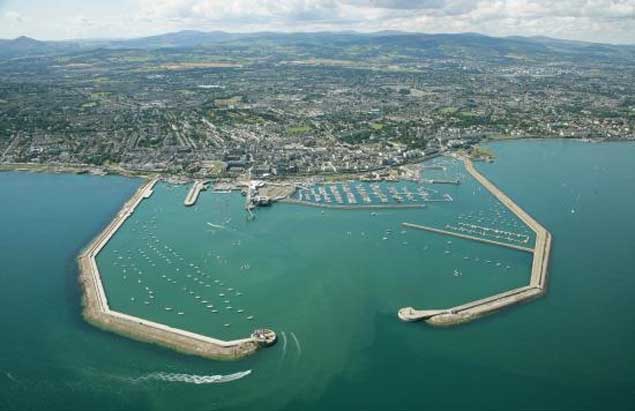 For smaller Drascombes, Dun Laoghaire Harbour is a complete cruising ground within itself
For smaller Drascombes, Dun Laoghaire Harbour is a complete cruising ground within itself
One of the reasons the Drascombes came up on the Dun Laoghaire radar is because the Sub-Committee were particularly impressed by the vibrant trailer-sailer section which is now to be found in the Old Gaffers Assocation, a section in which Drascombes play a signficant part.
It’s of interest that the OGA themselves have lately been paying closer attention to encouraging designs for smaller gaffers of good performance potential, and at the AGM in London last month, outgoing OGA President Sean Walsh of Dublin was able to unveil preliminary drawings of a concept by that versatile designer Andrew Wolstenholme of a 13ft 6ins “modern mini-gaffer” which the OGA wishes to encourage, with ease of amateur building a priority.
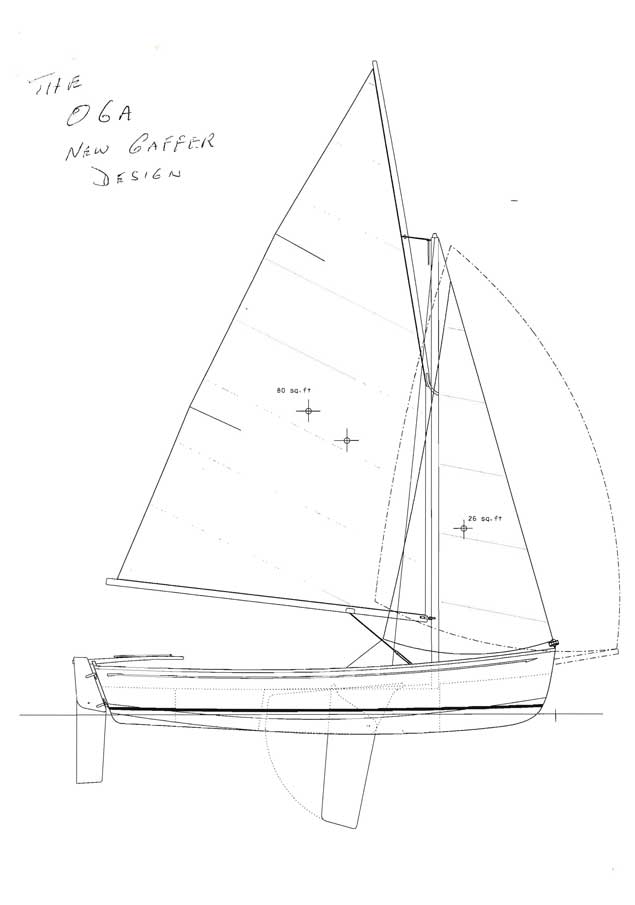 Concept drawing from Andrew Wolstenholme for the new 13ft 6ins “performance mini-gaffer” to be sponsored by the Old Gaffers Association
Concept drawing from Andrew Wolstenholme for the new 13ft 6ins “performance mini-gaffer” to be sponsored by the Old Gaffers Association
Equally Sean – who himself sails the 28ft Heard Falmouth Cutter Tir na nOg, a “plastic fantastic” – wished to record his own and the OGA’s appreciation of the work over the years of another boat designer from southwest England, and this is Roger Dongray, a house architect who many years ago found himself starting to design the little plastic gaffers which went on to become the Cornish range of Shrimpers, Crabbers and whatever, every one of them a characterful little boat which gives much pleasure and the extra sport of handling gaff rig to owners who have neither the resources nor skills to maintain an ageing wooden boat.
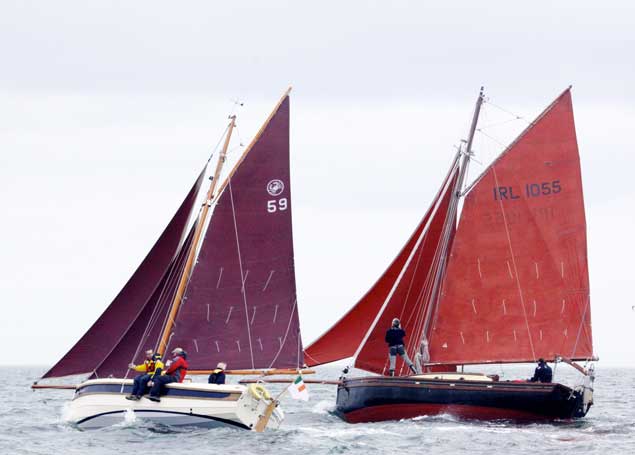 Dublin Bay OGA President Denis Aylmer’s Cornish Crabber Mona (left) and outgoing OGA President Sean Walsh’s Heard 28 Tir na nOg Photo: Dave Owens
Dublin Bay OGA President Denis Aylmer’s Cornish Crabber Mona (left) and outgoing OGA President Sean Walsh’s Heard 28 Tir na nOg Photo: Dave Owens
So Sean’s final duty before standing down, to be succeeded as President by Alistair Randall, was a formal presentation to acknowledge Roger Dongray’s special work in making gaffers interesting to modern-minded owners, and his skill in creating a recognisable style in a range of fibreglas-built gaff-rigged boats which are an adornment to any port or anchorage.
 The versatile Cornish Shrimper is one of Roger Dongray’s most popular designs.
The versatile Cornish Shrimper is one of Roger Dongray’s most popular designs.
In an era when the advent of foils means that we are seeing mono-hulls which have the potential to move at meaningless speeds, the sheer pleasure of coaxing the best performance out of a comfortable and characterful gaffer, aboard which your young family feels comfortable and secure, is something to be treasured, and it intrigued me to hear the other day that Olivier Prouveur, the Sailing Manager at the National YC and highly experienced in many kinds of craft, has bought himself a Cornish Shrimper as he reckons a boat like this provides very well for Dun Laoghaire sailing requirements – and yes, he does hope to race her for the Kingstown Cup in July.
Another area of possible participation where Cathy MacAaleavey has been casting her net is the three-masted Bantry Boats, but a problem she has discovered is that several are short of crews. One particular case is the one which was built in a community project at Banagaher on the Shannon, but unfortunately the key man in all this has moved on elsewhere, and they’ve a personnel problem.
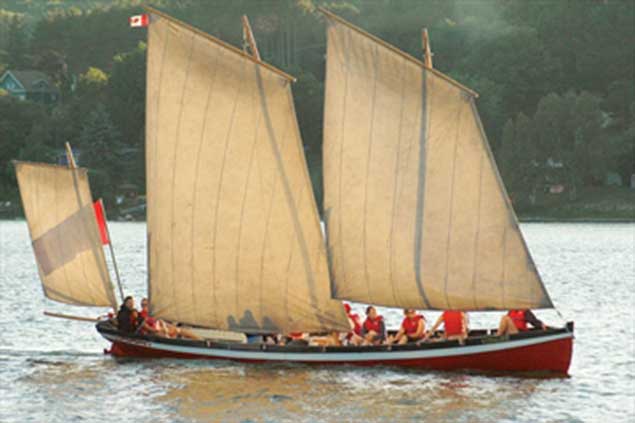 Bantry Boats need a lot of crew
Bantry Boats need a lot of crew
This in turn has opened up the possibility of the thriving coastal rowing clubs being a source of crewmen for the Bantry boats, for thanks to the enthusiastic support of the legendary Ger Ryan of St Michael’s Rowing Club underneath the arches beside Dun Laoghaire’s inner harbour, the outer harbour is going to be packed out with skiff racing crews from near and far on Sunday July 9th.
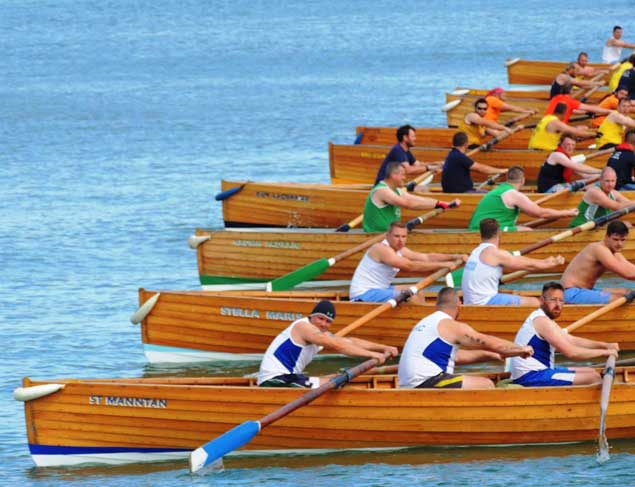 Manpower….the East Coast Rowing craft are an ancient style of boat going back to the era of the Dublin Bay hobblersFrom that comes the idea of an invitation being cast in the direction of the rowing skiffs of Strangford Lough. They’re much lighter and smaller boats than the traditional hefty East Coast craft which date back to the hobblers’ service boats of the 18th and 19th century. In Strangford Lough by contrast they used a highly-regarded Iain Ougthtred easy-build design, and a league developed as noted harbour pubs around the lough organized boat-building classes to provide an Oughtred skiff apiece. There are now nine boats which regularly turn out to race together, and it is of course thirsty work, which was probably the thinking all along.
Manpower….the East Coast Rowing craft are an ancient style of boat going back to the era of the Dublin Bay hobblersFrom that comes the idea of an invitation being cast in the direction of the rowing skiffs of Strangford Lough. They’re much lighter and smaller boats than the traditional hefty East Coast craft which date back to the hobblers’ service boats of the 18th and 19th century. In Strangford Lough by contrast they used a highly-regarded Iain Ougthtred easy-build design, and a league developed as noted harbour pubs around the lough organized boat-building classes to provide an Oughtred skiff apiece. There are now nine boats which regularly turn out to race together, and it is of course thirsty work, which was probably the thinking all along.
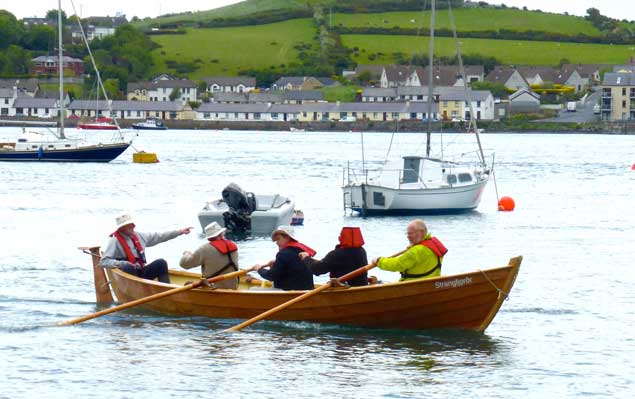 The Iain Oughtred-designed skiffs have established a league in Strangford Lough Photo W M Nixon
The Iain Oughtred-designed skiffs have established a league in Strangford Lough Photo W M Nixon
Whether or not they come to Dun Laoghaire in July is another matter altogether, interesting and all as it would be. But either way, we can be sure that the hugely varied fleet which is now shaping up for the Classics, Old Gaffers and Traditional Division of the Volvo Dun Laoghaire Bicentenary Regatta 2017 will find that whole-hearted participation is indeed very thirsty work.
#luggerroundireland – Two brothers will begin a circumnavigation of Ireland in an 18ft–Drascombe Lugger dinghy, Lughnasa this June bank holiday. Fergus and Nathaniel Ogden will set off on the c. 1000 mile voyage from Baltimore, West Cork. Hoping to achieve between 15-30 miles a day, they will live on-board the boat, calling into various stopovers along the coast - beginning with Crookhaven.
At an average speed of 3-4 knots, this won't be the fastest circumnavigation of Ireland ever achieved, but the Drascombe's rugged build quality makes it a fine boat for the job, and will be the first time an open Lugger has attempted to sail around Ireland.
They anticipate the voyage to take about a month, though the Atlantic conditions off the West Coast will play an important role in their journey time.
Aged 16 and 22, this will be the brother's longest voyage together. Personal space will take on a new meaning for the lads with cramped living on-board, and tensions are sure to run high as the 18 feet of Drascombe becomes home. Balmy days spent rolling on the long and gentle swells in the baking Irish sun will help reduce some of this pressure, however and provide plenty of opportunities for photo and video footage of the voyage. With none of the luxuries found inside a cabin, Facebook and website updates will be done as often as possible from their overnight stops.
The Ogdens are undertaking this challenge to raise funds for the RNLI, who are officially supporting their adventure.
By doing this they would like to help raise awareness for safety at sea as the number of lifeboat callouts for leisure craft has been increasing in recent years.
To keep up with the Ogden brother's progress visit their website where you can make a donation to the RNLI and follow their blog.

onboard the Lughnasa
ROUGH ROUTE PLAN, NOT CONSIDERING ALL CONTINGENCIES. LEAVING BALTIMORE AND HEADING WEST
Crookhaven
Castletown Bearhaven
Ballycrovane Harbour
Derrynane Harbour
Knightstown, Valentia
Dingle
Brandon
Kilrush/Carrigholt
Inishmore
+ /- Galway, Roundstone, Clifden, Cleggan
Inishbofin
Clare Island
Belmullet
Kilcummin
Rosebeg
Tory
+/- Lough Swilly Stopover
Portballintrae
Rathlin / Ballycastle
Donaghdee
Carlingford
Ardglass
Howth/Dun Laoghaire
Wicklow
Wexford
Kilmore Quay
Dungarvan
+/- Youghal
Cork Harbour - Crosshaven
Kinsale
Clonakilty
Glandore / Castletownshend
Baltimore
Torqeedo Owner's Revolt Against the Petrol Outboard Engine
#electricoutboard – Torqeedo owner Jack O'Keefe from Cork Harbour tells of his sailing adventures in a Drascombe Coaster and how after swapping from a petrol version the rewards from his new electric outboard engine are less noise, no smells, more stowage, better sailing performance and a motor that can be started by a small child. But it's still not silent, there's a whine...!
The thinking behind it...
My Drascombe is a Coaster, which has a small cabin with two berths. Drascombes are normally used as motorsailers and are rarely to be seen afloat without an outboard hanging in the well at the transom. The concept of sailing without dependence on an outboard motor and all that goes with it. viz. Carrying petrol, unreliability and the difficulty of starting, has been in my mind for a few years. I had a very reliable petrol 8hp outboard that my wife never had the strength of arm to start, and in event of capsize would keep the Coaster swamped due to its weight. After a couple of seasons minimising the use of the outboard – a promised tax refund was the final push to go electric. I saw in the Torqueedo promo videos how their motor is very light and unaffected by immersion. The use of Lithium Ion batteries and the option of a remote throttle were also strong factors in selecting the Torqueedo model over others.

Torqeedo's Travel 1003L – ease of starting the motor is a plus
I selected the Travel 1003L model on advice from the makers at the London Boat Show. I looked to purchasing on the internet but decided to buy from Union Chandlery on the basis that I might need support. The first use of the motor was in Morbihan Gulf and after being used in anger going through one of the tidal gates – the motor stopped and did not start again for the week. Union chandlery sent it back.– the manufacturers replaced it and when the original one got back to their workshop they found that heavy fishing line was caught invisibly inside the prop.
Outcome
I have now completed my third season with my electric motor. Since I fitted it and learned how to use it I got rid of the petrol outboard altogether. The big question with the electric motor is range, there is no doubt that I do more sailing – tacking in narrow channels and that I pay more attention to timing with regard to tide on passages. In the period of use I have on one occasion depended on a tow - after 26nm on the French canals and having passed the sea lock missing the last of the ebb while socialising in a raft up.
I have learned to appreciate the ease of starting the motor – place the magnetic key, turn the throttle and it runs – no pulling cords or twiddling choke. The stowage space created by not having a petrol can nor funnel, oil, spare plugs etc. is another unexpected boon. The other unexpected advantage is the sailing performance of the boat is greatly improved by not having a large mass of metal hanging on the stern. A charge costs less than a unit half a unit and is usually blagged from a pub or neighbour. A night in a marina means a chance to charge up all batteries and reserves.
Monitoring
The batteries come with built in GPS and electronics to calculate the distance left within the current charge. This is a useful tool to keep discipline and help to stretch the charge as long as possible. This adds to the cost of the batteries and I imagine the system could have been made part of the motor assembly rather than having to pay for a GPS and computer for each battery.
Lead Battery backup
The battery for the motor is 29.6 volt 520 WHr equivalent to a 43 AHr lead acid battery. Since the charge voltage for the battery is 12v a lead acid battery can be used to recharge the motor battery. I have made a jumper cable using a Maplin HH62S DC power plug with a 5A fuse in the cable so that the Li Ion battery can be charged up on board from a 50 AHr backup lead acid battery or the boat's main battery via the cigarette lighter socket. This option makes a big difference during longer cruises away from mains supplies – effectively giving another spare battery. Of course it also means the battery can be charged from the car while towing.
Solar
Charging is limited to 4A therefore at 12 v a 36w - 40w solar panel capacity is the correct size. This must be controlled to 12v – a complete charge taking in the order of 10 hours sunlight – so this solution is only applicable when the boat is moored up between voyages. I tend to use the solar panels to keep the lead acid batteries charged as they are more tolerant to fluctuations in voltage from the panels.
Living with electric
Using an electric motor for small boat cruising means you manage your cruise to suit the tides and be efficient. The rewards are less noise, no smells, more stowage, better sailing performance and a motor that can be started by a small child. I did expect the motor to be silent – in fact there is a clear electric whine with which one can easily tolerate. If you enjoy sailing, using an electric motor for day sailing is a "no-brainer" especially if you have a spare battery – and it helps if you are a green crank. A surprising disadvantage is that the noise and smoke from neighbouring outboards becomes exasperatingly exacerbated.
The electric motor provides all the power needed to get into and out of tight berths, or up sheltered channels. I have needed it once in emergency to get me clear of a lee shore at the Kedge in West Cork, but mostly it is run in calms and to get back to the moorings under the trees a mile upriver from Crosshaven. For me the electric motor is a step short of the goal of no motor – and with my experience so far I believe there is no need to go that far!



























